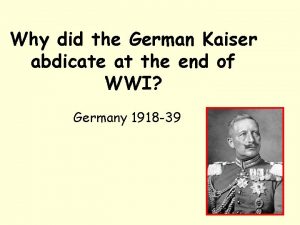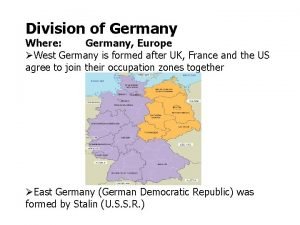ARMISTICE WHY DID GERMANY SURRENDER The German surrender










- Slides: 10

ARMISTICE WHY DID GERMANY SURRENDER

The German surrender was the product of events in 1918. By the end of 1917, an Allied victory in Europe was far from certain. The Americans had come into the war – but Russia, overtaken by socialist revolutionaries, had pulled out. The threat of strikes – or worse still, a workers’ revolution – plagued the governments of all major powers. Across the continent support for the war slipped to its lowest level, the public weary of casualty lists, food shortages and promises of victory that never materialised.

But like the Schlieffen Plan, the Spring Offensive was tactically flawed. The forward wave of stormtroopers moved more quickly than their supply lines, and constantly found themselves short of food, ammunition and reinforcements. The use of Germany’s best troops in an advance capacity meant they also suffered a higher rate of casualties, while the quality of rear defensive positions was weakened. The Spring Offensive gained significant ground but at a significant cost, and by July 1918 the assault had lost momentum. Germany had lost almost one million men in a six month period. Its military planners calculated that 1. 1 million new soldiers would be needed to sustain the war effort into 1919 – but they also predicted that conscription would barely fill one-quarter of this quota.

By mid-1918 the Americans were arriving in numbers, around 10, 000 each day. The Allies were also bolstered by fresh divisions of Australian and Canadian troops, who would play a leading role in the counter-offensive. Allied forces broke through the German lines at Amiens and the Somme, with considerable loss on both sides. This sparked German retreats up and down the Western Front, with more than two dozen significant battles between August and October. The Germans were pushed back to the Hindenburg Line – a series of defences and fortifications well behind the front – and Allied troops even managed to penetrate this line at a couple of points. Momentum was now clearly with the Allies

Germany’s situation was further imperilled by her domestic conditions. By the winter of 1917 -18, the availability of food in German cities was critically low. The British naval blockade of German ports had halted food imports, and Berlin’s reallocation of agricultural labour to industry affected domestic production. The harvests of 1917 produced 12 million tons, down from 21 million tons in 1913. A disproportionate share of this was set aside for the military: civilians received 33 per cent of the grain, though they comprised 67 per cent of the population. Germans were consuming pitifully low amounts of meat (12 per cent of pre-war levels) fish (five per cent) and eggs (13 per cent). German farmers, able to grow their own produce, were coping – but the situation in many cities had become drastic. There were reports of malnourished factory workers collapsing at their machinery, of widespread outbreaks of dysentery, and of skin-and-bones children begging in groups on major streets. Civilian deaths in 1918 increased by more than 200, 000 from the previous year, chiefly because of starvation. Ten per cent of hospital patients, including many women in childbirth, were reported to have died because of food shortages. This suffering spanned the entirety of 1918 and continued through much of 1919, as the Allies continued the food blockade during the peace negotiations in Paris.

Germany Isolated Germany’s position was also weakened by the loss of her allies in the autumn of 1918. Berlin’s largest ally in the Balkans, Bulgaria, signed an armistice with the Allies on September 29 th 1918. The Ottoman Empire had endured a series of defeats in Egypt, Palestine, Syria and the Caucasus. Pushed back to the area now held by Turkey, the Ottomans signed an armistice on October 30 th. But the most critical loss was the submission of the Austro-Hungarians. Through 191718 the Dual Monarchy was beset with its own internal political and economic problems. The 86 year-old emperor Franz Josef had died in November 1916, and his successor, Charles I, had little interest in continuing the war

Through an intermediary the young emperor secretly attempted to negotiate a peace with the Allies, without the involvement or knowledge of Germany. This offer was rejected but news of it was passed to Berlin; the revelation caused friction between the two Central Powers. Charles I was also confronted by rising nationalist movements in the empire, as ethnic groups – Czechs, Slovaks, Slavs and others – demanded independence. Vienna eventually signed an armistice on November 3 rd 1918, ending its participation in the war. A week later Charles I abdicated his sovereign power over both kingdoms, effectively abolishing the empire

At the start of November 1918, a sailors’ mutiny in Kiel lit the fuse of revolution in Germany. Within a week more than a dozen major cities were effectively controlled by mutinous soldiers, sailors and left-wing revolutionary groups. Pressured to abdicate, Kaiser Wilhelm stalled for a couple of days, while attempting to organise military units to crush the rebels. Advised by his generals that he no longer enjoyed the loyalty of the military, Wilhelm consented to abdicate the imperial throne. His abdication was announced by the German chancellor, Prince Max von Baden, on November 9 th. At this time, German politician Matthias Erzberger was in Picardie, northern France, commencing armistice negotiations with French generals. The ceasefire was signed in a French rail car just before dawn two days later. -

Six hours later, as per the terms of the armistice, the guns of World War I fell silent. By sheer coincidence, it was 11. 00 am on the 11 th day of the 11 th month. The chant which had echoed through the streets of London in August 1914, ‘It’ll be over by Christmas!’, had finally come to fruition – though it had taken four more Christmases and millions more lives than anyone had expected. - See more at: http: //alphahistory. com/worldwar 1/germansurrender/#sthash. z. Q 3 NPUm 5. dpuf

1. Germany’s generals staked their war fortunes on a major offensive in 1918, while the Allies planned for 1919. 2. The German Spring Offensive was led by specialist stormtroopers, who pushed back the Allies as much as 60 miles. 3. However a number of factors, including shortages of men and munitions, saw the German advance slow and stall. 4. The domestic situation in Germany was also deteriorating, due largely to food shortages caused by the Allied blockade. 5. The failure of the Spring Offensive and the loss of her allies in mid- to late-1918 eventually resulted in a German surrender and the signing of a ceasefire on November 11 th 1918
 Walmart germany
Walmart germany Why did germany avoid “wounding austria too severely”?
Why did germany avoid “wounding austria too severely”? Where did general lee surrender to general grant?
Where did general lee surrender to general grant? Why did the kaiser abdicate in 1918
Why did the kaiser abdicate in 1918 Why was everyone celebrating in denmark number the stars
Why was everyone celebrating in denmark number the stars Pictures
Pictures Low german vs high german
Low german vs high german Gelled blackthorns of your hair
Gelled blackthorns of your hair Encumbered antonym
Encumbered antonym What is an armistice? *
What is an armistice? * Three days before armistice sunday
Three days before armistice sunday


















